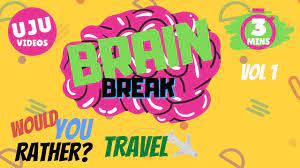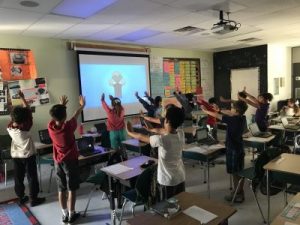Student Contributor: J. Pruneda
 Would you rather is a brain break strategy used for the whole class. This tool will help students take a break from their learning and get help to activate, energize and stimulate their brains. Would you rather will also improve students’ concentration and relieve stress.
Would you rather is a brain break strategy used for the whole class. This tool will help students take a break from their learning and get help to activate, energize and stimulate their brains. Would you rather will also improve students’ concentration and relieve stress.
Would you rather – movement version is a brain break that is used to help students distress from thinking so much on long lessons. Students who learn and think differently sometimes get tired easily, have a low tolerance for frustration, or have trouble figuring out how to approach their work. Switching up what they’re doing for a few minutes can help break those patterns. This tool can be modified or simply done by playing a video. The video will include asking questions followed by an exercise movement that the students will perform. It is important to keep in mind that every student and teacher in the classroom should perform to ensure all brains get a little refreshment. Teachers should also keep in mind the space around the classroom so that students are safe to participate. Personally, I have experienced a touch of this tool growing up. I remember having to choose a side of the classroom based on my answer then explaining my why. I did get a brain break from the lesson and came back to the lesson as a great start.
 Would you rather was placed in the supportive phase. This tool was placed as supportive because it supports students to continue making the prosocial choices needed for their own and their peers’ benefit. This tool will help students stay focused by getting a break and then going back to learning with a fresh start. By providing this tool to the students, the teacher is giving the student encouragement to not give up on trying but yet to take a brain break. This tool can also fall into the preventative phase because it is important to have a good classroom setup so that students are aware of the performance that can happen around the classroom. The theory that best fits this tool is teacher-centered and collaborative. It is important for the teacher to know when to make the choice of having a brain break and also performing a brain break that will benefit all students. Would you rather can also be collaborative because both the teacher and the students are performing to be better at learning by giving their brain a break.
Would you rather was placed in the supportive phase. This tool was placed as supportive because it supports students to continue making the prosocial choices needed for their own and their peers’ benefit. This tool will help students stay focused by getting a break and then going back to learning with a fresh start. By providing this tool to the students, the teacher is giving the student encouragement to not give up on trying but yet to take a brain break. This tool can also fall into the preventative phase because it is important to have a good classroom setup so that students are aware of the performance that can happen around the classroom. The theory that best fits this tool is teacher-centered and collaborative. It is important for the teacher to know when to make the choice of having a brain break and also performing a brain break that will benefit all students. Would you rather can also be collaborative because both the teacher and the students are performing to be better at learning by giving their brain a break.
More Information –
Tool Source: Minds in Bloom – https://bit.ly/3nEZDwW
https://bit.ly/3nEdvYd


I used Would You Rather – Movement Version in a third-grade classroom with 15 students, and the school is in a suburban setting. This tool was simple to implement in the classroom, as students are familiar with would you rather questions. With explicit instructions, students understood that they needed to do a movement that correlated with their answer. Because of COVID restrictions, I could not have the students move to different sides of the room. Instead, they just stood by their desks and did the movement in place. One example of a time I used it was halfway through a math lesson before doing independent work. I asked if they would rather live in the ocean or the jungle, and they did high knees for the ocean and jumping jacks for the jungle for 30 seconds. Students had a chance to make noise and get out some energy which led to very successful independent work time. I think one thing that might be helpful is a provided list of simple exercises and would you rather questions in case the teacher runs out of ideas.
Wiggle World: 18 students, Suburban, 2nd grade, Supportive, Teacher directed & Collaborative
This tool falls under “Brain breaks.” So I wanted to comment on my experience with the brain break my mentor teacher and I have implemented in his classroom. It varies a bit from your post about your brain break, but they align closely. This tool was being used in my placement by my mentor teacher. When the teacher had a lesson planned that required students to work independently or quietly, they would say, “We are going to go to wiggle world. Remember, on wiggle world, we keep our hands and feet to ourselves, and we make sure to stay out of other student’s bubbles.” Kid would then begin walking around the room, wiggling all around. They could talk to other students about anything they would like and talk at a volume louder than they normally would. This would continue for about 3 minutes, give or take, and the teacher would end wiggle world with a chime tool the students are accustomed to, and the students would return to their seats. I had observed my mentor teacher doing this tool a few times, and when I implemented it, students responded just as they had with the mentor teacher.
Would you rather? – Movement Version (Supportive)
I used this tool in a 4th grade classroom with 20 students. I choose this tool because we have been working on point of view in ELA. I thought that this could be a good brain break for the students to support them and allow them to get some of their energy out. This tool was very easy to use and to explain the rules to students. We would ask a would you rather question and for the first answer students would go to the right of the room and for the second answer students would go to the left side of the room. Not only was this a great was for kids to relate to point of view writing it was a good way for them to talk with their peers and get their energy out.